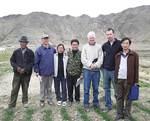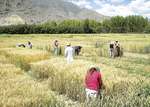Adelaide's farming research travels to Tibet
 Agriculture Agriculture
A University of Adelaide-led project to help Tibetan farmers increase their grain, fodder and milk production is helping to drive agricultural development in one of the world's poorest countries. The project, now in its fifth year, has introduced new cropping practices into Tibet and trained young scientists from the Tibet Agricultural Research Institute (TARI) in techniques aimed at increasing farmers' average income of about $2 a day. Led by Agronomy Chair Professor David Coventry and Dr Nick Paltridge from the School of Agriculture, Food and Wine, the project has also resulted in the University welcoming its first - and believed only - Tibetan student in its 135-year history. Pebu Drolma is studying for her Masters of Plant Health and Biosecurity at the Waite Campus after winning a prestigious John Allwright Scholarship from the Australian Centre for International Agricultural Research (ACIAR). The 33-year-old from western Tibet has an undergraduate degree in agronomy from the Southwest Agricultural University in China and is in the first year of her Masters, specialising in plant diseases. Her home town is Ngari, located 4500 metres above sea level and inhabited by yaks, Tibetan antelopes and wild donkeys. Often referred to as the "Roof of the World", Nagari is the homeland of the Tibetan religion Buddhism. Prior to starting her Masters degree, Drolma undertook five months of intensive English language training in Adelaide. "This is a wonderful opportunity for me," Drolma said. "I hope to learn as much as possible about plant diseases so I can work directly with Tibetan farmers and improve their crop yields." Also benefitting from the University's research work in Tibet is recent Bachelor of Agriculture graduate Tim Heath, who has won an Australian Youth Ambassador for Development award to work in Tibet for several months. Tim, 21, will work alongside Dr Paltridge in Tibet for part of this year, helping to combat weeds which compete with arable crops in that region. Around half of Tibet's 2.7 million people practise intensive agriculture and keep livestock in a network of valleys located at between 3500 and 3950 metres above sea level. "Farming systems are heavily focused on the production of spring barley and winter wheat and current levels of production provide sufficient grain for human needs," Dr Paltridge said. "However, the existing system provides little fodder for animals and, consequently, livestock - in particular dairy cattle - do not produce much milk and often die in Tibet's harsh winters." In the first stage of the project, existing agronomy systems in Tibet were reviewed, providing a foundation for additional agricultural research and development, both locally at TARI and with international collaborators. Working in tandem with the University of Adelaide on this project are the NSW Department of Primary Industries, Rural Solutions SA and the University of Queensland. The project is being funded by ACIAR. The team of researchers is now working on the second stage of the project, which presents some daunting challenges. "Over the next three years we want to increase household income and industry productivity in Tibet," Dr Paltridge said. "This will be done by developing community-based initiatives in dairy, crop and fodder production for farmers in the central valleys of Tibet." Eight Australians and up to 20 Chinese and Tibetan researchers are involved in the project, predominantly from TARI, with several undertaking training at the University of Adelaide over the past four years. "We have helped to identify new fodder crops that are suitable for growing in Tibet and introduced systems for fodder production that do not have adverse impacts on grain production. "Cereal crops are the staple food for Tibetan farmers so we can't substitute them for fodder crops, but we can intercrop wheat with vetch and lucerne crops. "The end result is that you can feed both humans and livestock," Dr Paltridge said. Professor Coventry said the majority of grain produced in Tibet is for household use, but any surplus is a welcome outcome as it helps to boost farmers' incomes. "They may not be driven by a profit motive the way we are in the developed world, but if they can produce more grain and fodder without extra labour they are happy to sell the surplus and improve their income. "Tibet has rich soils, sufficient moisture and a lot of sunshine - great conditions for growing crops and fodder. Our job is to help optimise output from these conditions," Professor Coventry said. Story by Candy Gibson
|







